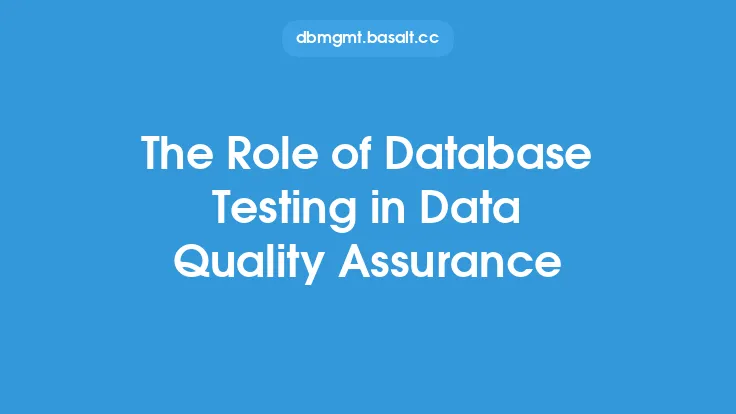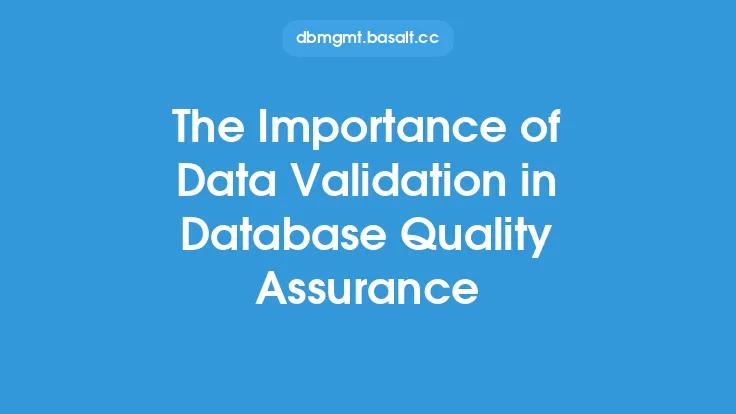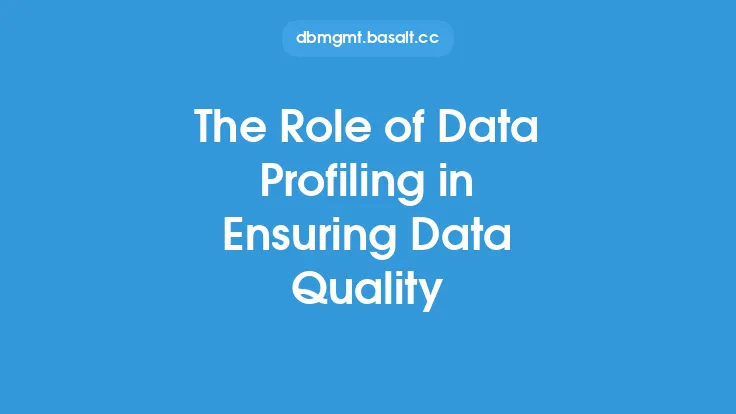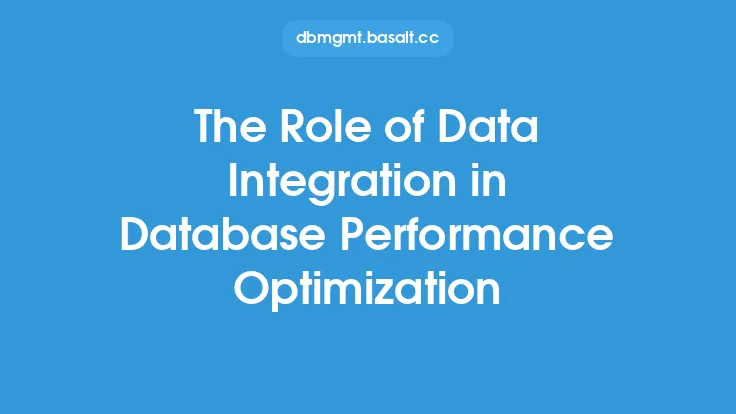Data profiling is a crucial step in the database quality assurance process, as it enables organizations to understand the distribution, patterns, and relationships within their data. This process involves analyzing and summarizing large datasets to identify trends, anomalies, and correlations, which can help improve data quality, reduce errors, and increase overall database performance. In this article, we will delve into the role of data profiling in database quality assurance, its benefits, and the techniques used to profile data.
Introduction to Data Profiling
Data profiling is a systematic process that involves collecting, analyzing, and reporting statistics and information about the data in a database. This process helps organizations to understand the structure, content, and quality of their data, which is essential for making informed decisions, identifying data quality issues, and improving overall database performance. Data profiling can be performed using various techniques, including data visualization, statistical analysis, and data mining. The goal of data profiling is to provide a comprehensive understanding of the data, including its distribution, patterns, and relationships, which can help organizations to identify areas for improvement and optimize their database systems.
Benefits of Data Profiling
Data profiling offers several benefits to organizations, including improved data quality, reduced errors, and increased database performance. By analyzing and summarizing large datasets, organizations can identify trends, anomalies, and correlations that may indicate data quality issues. For example, data profiling can help identify duplicate records, invalid data, and inconsistent formatting, which can be corrected to improve data quality. Additionally, data profiling can help organizations to optimize their database systems, reduce storage costs, and improve query performance. By understanding the distribution and patterns of their data, organizations can design more efficient database systems, optimize storage and retrieval processes, and improve overall database performance.
Data Profiling Techniques
There are several data profiling techniques that can be used to analyze and summarize large datasets. These techniques include:
- Data visualization: This technique involves using graphical representations to display data, making it easier to understand and analyze. Data visualization can help identify trends, patterns, and correlations within the data.
- Statistical analysis: This technique involves using statistical methods to analyze and summarize data. Statistical analysis can help identify trends, patterns, and correlations within the data, as well as detect anomalies and outliers.
- Data mining: This technique involves using automated methods to discover patterns and relationships within large datasets. Data mining can help identify trends, patterns, and correlations within the data, as well as detect anomalies and outliers.
- Data quality metrics: This technique involves using metrics to measure data quality, such as accuracy, completeness, and consistency. Data quality metrics can help identify areas for improvement and track progress over time.
Data Profiling Tools
There are several data profiling tools available that can help organizations to analyze and summarize large datasets. These tools include:
- Data profiling software: This type of software is specifically designed for data profiling and can help organizations to analyze and summarize large datasets.
- Database management systems: Many database management systems, such as Oracle and Microsoft SQL Server, offer built-in data profiling tools that can help organizations to analyze and summarize large datasets.
- Data integration tools: Data integration tools, such as Informatica and Talend, can help organizations to integrate data from multiple sources and perform data profiling tasks.
- Data analytics platforms: Data analytics platforms, such as Tableau and Power BI, can help organizations to analyze and visualize large datasets, making it easier to identify trends, patterns, and correlations.
Best Practices for Data Profiling
To get the most out of data profiling, organizations should follow best practices, such as:
- Define clear goals and objectives: Before starting a data profiling project, organizations should define clear goals and objectives, such as improving data quality or optimizing database performance.
- Choose the right tools: Organizations should choose the right tools for their data profiling needs, such as data profiling software or database management systems.
- Use a combination of techniques: Organizations should use a combination of data profiling techniques, such as data visualization, statistical analysis, and data mining, to get a comprehensive understanding of their data.
- Involve stakeholders: Organizations should involve stakeholders, such as data analysts and business users, in the data profiling process to ensure that the results are relevant and useful.
Common Challenges in Data Profiling
Data profiling can be a complex and challenging process, especially when dealing with large and complex datasets. Some common challenges in data profiling include:
- Data quality issues: Poor data quality can make it difficult to profile data, as it can lead to inaccurate or incomplete results.
- Data volume and complexity: Large and complex datasets can be difficult to profile, as they can require significant resources and expertise.
- Lack of standardization: Lack of standardization in data formatting and structure can make it difficult to profile data, as it can lead to inconsistencies and errors.
- Limited resources: Limited resources, such as budget and personnel, can make it difficult to perform data profiling tasks, especially when dealing with large and complex datasets.
Conclusion
Data profiling is a crucial step in the database quality assurance process, as it enables organizations to understand the distribution, patterns, and relationships within their data. By using data profiling techniques, such as data visualization, statistical analysis, and data mining, organizations can identify trends, anomalies, and correlations that may indicate data quality issues. Additionally, data profiling can help organizations to optimize their database systems, reduce storage costs, and improve query performance. By following best practices and using the right tools, organizations can get the most out of data profiling and improve the overall quality of their data.





